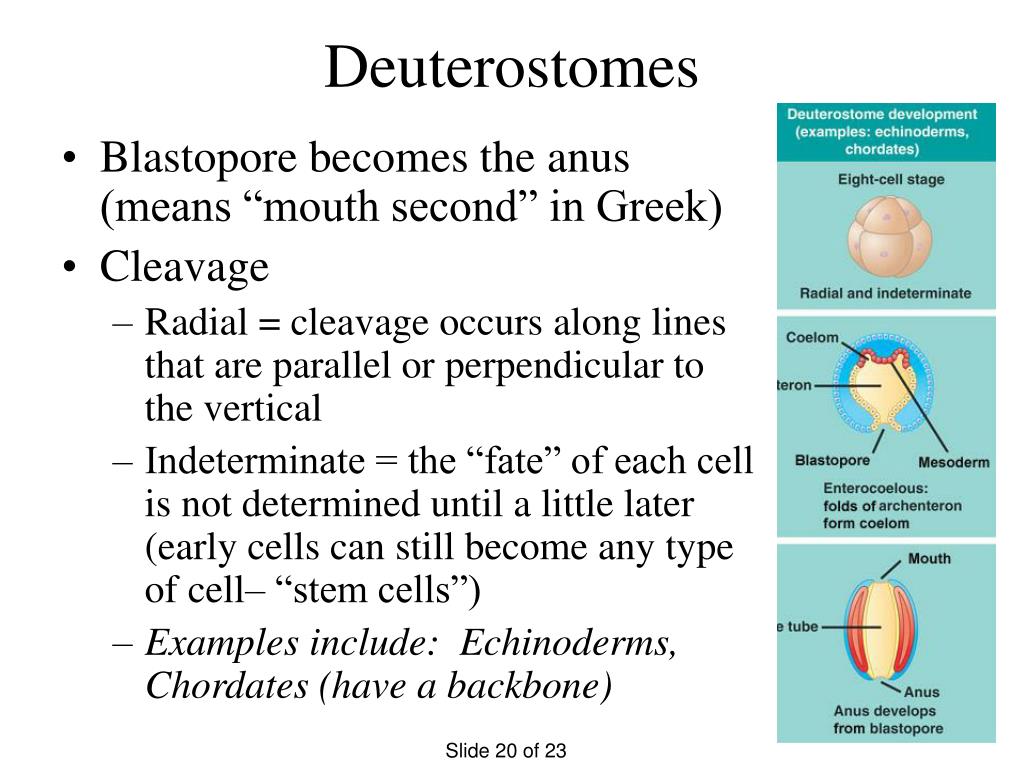

- #In the protostome line the blastopore becomes the how to#
- #In the protostome line the blastopore becomes the skin#
For example, the outer germ layer (or ectoderm) always becomes the nervous system and skin (or its associated scales, feathers, or hair) in all animals in the Bilateria clade. Each germ layer always becomes the same type of tissue in adult animals. The bodies of all animals in the clade Bilateria are formed from three germ layers. Simple animals like jellyfish only form two germ layers: an outer layer, or ectoderm, and an inner layer, or endoderm.Īnother evolutionary step occurred when some animals developed a third, middle germ layer, called the mesoderm. They begin development as a single cell (zygote) that multiplies and becomes a ball of cells (embryo), which then forms into tissues called germ layers. We call all animals with tissues the Eumetazoa. This gave those animals such an evolutionary advantage that almost all animals today have tissues. Tissues are groups of cells, like skin cells, working together on the same job.Īt some point early in the evolutionary history of animals (about 940 million years ago), scientists believe that some of the Parazoa started to form tissues during development. They have specialized cells that perform different functions within the organism but their cells do not join together to form tissues. The animals in both phyla are asymmetrical. Sponges are joined by another phylum, Placozoa, in a clade called the Parazoa. They're bright pink, purple, and orange sponges that live in the ocean and make up the phylum Porifera. We're talking about the SpongeBob SquarePants type of sponge. We are not talking about the type of sponge at the kitchen sink. Tissuesĭinosaurs are prehistoric and extinct, but they are not the most primitive animals. Choanoflagellates are protists that live in colonies and are thought to be the living organisms most closely related to animals. Fifteen of the most significant animal phyla (of approximately 35 total) are shown. The labels on the branches show when a particular trait evolved. The colored bars at top mark clades based on similar developmental structures. Each evolutionary adaptation is marked on the cladogram to indicate when it arose within the "family tree."Ĭladogram of major animal phyla based on development. We'll use the cladogram below to see how scientists use homologous patterns of development to help them classify animals. Saving Earth Britannica Presents Earth’s To-Do List for the 21st Century.It's time to get classy-cladogram classification classy.Britannica Beyond We’ve created a new place where questions are at the center of learning.100 Women Britannica celebrates the centennial of the Nineteenth Amendment, highlighting suffragists and history-making politicians.
#In the protostome line the blastopore becomes the how to#
COVID-19 Portal While this global health crisis continues to evolve, it can be useful to look to past pandemics to better understand how to respond today.Student Portal Britannica is the ultimate student resource for key school subjects like history, government, literature, and more.From tech to household and wellness products. Britannica Explains In these videos, Britannica explains a variety of topics and answers frequently asked questions.This Time in History In these videos, find out what happened this month (or any month!) in history.#WTFact Videos In #WTFact Britannica shares some of the most bizarre facts we can find.Demystified Videos In Demystified, Britannica has all the answers to your burning questions.Britannica Classics Check out these retro videos from Encyclopedia Britannica’s archives.


 0 kommentar(er)
0 kommentar(er)
